#series: annals of the seven
Text
The First Light of Trinity
— By Alex Wellerstein | July 16, 2015 | Annals of Technology

Seventy years ago, the flash of a nuclear bomb illuminated the skies over Alamogordo, New Mexico. Courtesy Los Alamos National Laboratory
The light of a nuclear explosion is unlike anything else on Earth. This is because the heat of a nuclear explosion is unlike anything else on Earth. Seventy years ago today, when the first atomic weapon was tested, they called its light cosmic. Where else, except in the interiors of stars, do the temperatures reach into the tens of millions of degrees? It is that blistering radiation, released in a reaction that takes about a millionth of a second to complete, that makes the light so unearthly, that gives it the strength to burn through photographic paper and wound human eyes. The heat is such that the air around it becomes luminous and incandescent and then opaque; for a moment, the brightness hides itself. Then the air expands outward, shedding its energy at the speed of sound—the blast wave that destroys houses, hospitals, schools, cities.
The test was given the evocative code name of Trinity, although no one seems to know precisely why. One theory is that J. Robert Oppenheimer, the head of the U.S. government’s laboratory in Los Alamos, New Mexico, and the director of science for the Manhattan Project, which designed and built the bomb, chose the name as an allusion to the poetry of John Donne. Oppenheimer’s former mistress, Jean Tatlock, a student at the University of California, Berkeley, when he was a professor there, had introduced him to Donne’s work before she committed suicide, in early 1944. But Oppenheimer later claimed not to recall where the name came from.
The operation was designated as top secret, which was a problem, since the whole point was to create an explosion that could be heard for a hundred miles around and seen for two hundred. How to keep such a spectacle under wraps? Oppenheimer and his colleagues considered several sites, including a patch of desert around two hundred miles east of Los Angeles, an island eighty miles southwest of Santa Monica, and a series of sand bars ten miles off the Texas coast. Eventually, they chose a place much closer to home, near Alamogordo, New Mexico, on an Army Air Forces bombing range in a valley called the Jornada del Muerto (“Journey of the Dead Man,” an indication of its unforgiving landscape). Freshwater had to be driven in, seven hundred gallons at a time, from a town forty miles away. To wire the site for a telephone connection required laying four miles of cable. The most expensive single line item in the budget was for the construction of bomb-proof shelters, which would protect some of the more than two hundred and fifty observers of the test.
The area immediately around the bombing range was sparsely populated but not by any means barren. It was within two hundred miles of Albuquerque, Santa Fe, and El Paso. The nearest town of more than fifty people was fewer than thirty miles away, and the nearest occupied ranch was only twelve miles away—long distances for a person, but not for light or a radioactive cloud. (One of Trinity’s more unusual financial appropriations, later on, was for the acquisition of several dozen head of cattle that had had their hair discolored by the explosion.) The Army made preparations to impose martial law after the test if necessary, keeping a military force of a hundred and sixty men on hand to manage any evacuations. Photographic film, sensitive to radioactivity, was stowed in nearby towns, to provide “medical legal” evidence of contamination in the future. Seismographs in Tucson, Denver, and Chihuahua, Mexico, would reveal how far away the explosion could be detected.

The Trinity test weapon. Courtesy Los Alamos National Laboratory
On July 16, 1945, the planned date of the test, the weather was poor. Thunderstorms were moving through the area, raising the twin hazards of electricity and rain. The test weapon, known euphemistically as the gadget, was mounted inside a shack atop a hundred-foot steel tower. It was a Frankenstein’s monster of wires, screws, switches, high explosives, radioactive materials, and diagnostic devices, and was crude enough that it could be tripped by a passing storm. (This had already happened once, with a model of the bomb’s electrical system.) Rain, or even too many clouds, could cause other problems—a spontaneous radioactive thunderstorm after detonation, unpredictable magnifications of the blast wave off a layer of warm air. It was later calculated that, even without the possibility of mechanical or electrical failure, there was still more than a one-in-ten chance of the gadget failing to perform optimally.
The scientists were prepared to cancel the test and wait for better weather when, at five in the morning, conditions began to improve. At five-ten, they announced that the test was going forward. At five-twenty-five, a rocket near the tower was shot into the sky—the five-minute warning. Another went up at five-twenty-nine. Forty-five seconds before zero hour, a switch was thrown in the control bunker, starting an automated timer. Just before five-thirty, an electrical pulse ran the five and a half miles across the desert from the bunker to the tower, up into the firing unit of the bomb. Within a hundred millionths of a second, a series of thirty-two charges went off around the device’s core, compressing the sphere of plutonium inside from about the size of an orange to that of a lime. Then the gadget exploded.
General Thomas Farrell, the deputy commander of the Manhattan Project, was in the control bunker with Oppenheimer when the blast went off. “The whole country was lighted by a searing light with the intensity many times that of the midday sun,” he wrote immediately afterward. “It was golden, purple, violet, gray, and blue. It lighted every peak, crevasse, and ridge of the nearby mountain range with a clarity and beauty that cannot be described but must be seen to be imagined. It was that beauty the great poets dream about but describe most poorly and inadequately.” Twenty-seven miles away from the tower, the Berkeley physicist and Nobel Prize winner Ernest O. Lawrence was stepping out of a car. “Just as I put my foot on the ground I was enveloped with a warm brilliant yellow white light—from darkness to brilliant sunshine in an instant,” he wrote. James Conant, the president of Harvard University, was watching from the V.I.P. viewing spot, ten miles from the tower. “The enormity of the light and its length quite stunned me,” he wrote. “The whole sky suddenly full of white light like the end of the world.”

In its first milliseconds, the Trinity fireball burned through photographic film. Courtesy National Archives and Records Administration
Trinity was filmed exclusively in black and white and without audio. In the main footage of the explosion, the fireball rises out of the frame before the cameraman, dazed by the sight, pans upward to follow it. The written accounts of the test, of which there are many, grapple with how to describe an experience for which no terminology had yet been invented. Some eventually settle on what would become the standard lexicon. Luis Alvarez, a physicist and future participant in the Hiroshima bombing, viewed Trinity from the air. He likened the debris cloud, which rose to a height of some thirty thousand feet in ten minutes, to “a parachute which was being blown up by a large electric fan,” noting that it “had very much the appearance of a large mushroom.” Charles Thomas, the vice-president of Monsanto, a major Manhattan Project contractor, observed the same. “It looked like a giant mushroom; the stalk was the thousands of tons of sand being sucked up by the explosion; the top of the mushroom was a flowering ball of fire,” he wrote. “It resembled a giant brain the convolutions of which were constantly changing.”
In the months before the test, the Manhattan Project scientists had estimated that their bomb would yield the equivalent of between seven hundred and five thousand tons of TNT. As it turned out, the detonation force was equal to about twenty thousand tons of TNT—four times larger than the expected maximum. The light was visible as far away as Amarillo, Texas, more than two hundred and eighty miles to the east, on the other side of a mountain range. Windows were reported broken in Silver City, New Mexico, some hundred and eighty miles to the southwest. Here, again, the written accounts converge. Thomas: “It is safe to say that nothing as terrible has been made by man before.” Lawrence: “There was restrained applause, but more a hushed murmuring bordering on reverence.” Farrell: “The strong, sustained, awesome roar … warned of doomsday and made us feel that we puny things were blasphemous.” Nevertheless, the plainclothes military police who were stationed in nearby towns reported that those who saw the light seemed to accept the government’s explanation, which was that an ammunition dump had exploded.
Trinity was only the first nuclear detonation of the summer of 1945. Two more followed, in early August, over Hiroshima and Nagasaki, killing as many as a quarter of a million people. By October, Norris Bradbury, the new director of Los Alamos, had proposed that the United States conduct “subsequent Trinity’s.” There was more to learn about the bomb, he argued, in a memo to the new coördinating council for the lab, and without the immediate pressure of making a weapon for war, “another TR might even be FUN.” A year after the test at Alamogordo, new ones began, at Bikini Atoll, in the Marshall Islands. They were not given literary names. Able, Baker, and Charlie were slated for 1946; X-ray, Yoke, and Zebra were slated for 1948. These were letters in the military radio alphabet—a clarification of who was really the master of the bomb.

Irradiated Kodak X-ray film. Courtesy National Archives and Records Administration
By 1992, the U.S. government had conducted more than a thousand nuclear tests, and other nations—China, France, the United Kingdom, and the Soviet Union—had joined in the frenzy. The last aboveground detonation took place over Lop Nur, a dried-up salt lake in northwestern China, in 1980. We are some years away, in other words, from the day when no living person will have seen that unearthly light firsthand. But Trinity left secondhand signs behind. Because the gadget exploded so close to the ground, the fireball sucked up dirt and debris. Some of it melted and settled back down, cooling into a radioactive green glass that was dubbed Trinitite, and some of it floated away. A minute quantity of the dust ended up in a river about a thousand miles east of Alamogordo, where, in early August, 1945, it was taken up into a paper mill that manufactured strawboard for Eastman Kodak. The strawboard was used to pack some of the company’s industrial X-ray film, which, when it was developed, was mottled with dark blotches and pinpoint stars—the final exposure of the first light of the nuclear age.
#Hiroshima | Japan 🇯🇵 | John Donne | Manhattan Project | Monsanto#Nagasaki | Japan 🇯🇵 | Nuclear Weapons | Second World War | World War II#The New Yorker#Alex Wellerstein#Los Alamos National Laboratory#New Mexico#J. Robert Oppenheimer#John Donne#Jean Tatlock#University of California Berkeley#Jornada del Muerto | Journey of the Dead Man#General Thomas Farrell#Nobel Prize Winner Physicist Ernest O. Lawrence#Luis Alvarez#US 🇺🇸#China 🇨🇳#France 🇫🇷#Soviet Union (Now Russia 🇷🇺)#Alamogordo | New Mexico#Eastman Kodak#Nuclear Age
38 notes
·
View notes
Text
Buffy the Vampire Slayer: Welcome to the Hellmouth, S01E01
My 2024 Buffy the Vampire Slayer rewatch starts NOW!

Before I jump in, here’s some quick housekeeping:
I’ll endeavour to do this on a weekly basis; watching an episode on Saturday night and writing up a post on Sunday.
I’m not going to worry about spoilers. This show was as good as it was because of how interconnected the themes and storylines were, so if something in season one reminds me of something in season seven, I’m going to mention it.
This is the first time I’ve watched this show (probably) since high school, and it’s almost certainly the first time I’ve watched it from start to finish. It’s actually rather dizzying in this age of eight episode shows that get cancelled after two seasons to consider there are one hundred and forty-four episodes of Buffy that span seven years.
Obviously I am not unaware of Joss Whedon’s mistreatment of others on the set of Buffy, and where it seems relevant I’ll bring it up. But I also don’t think it’s fair to the rest of the cast and crew to throw the entire show under the bus because of one person, especially when it had such a huge (positive) impact on so many lives.
For the record, my favourite ships are Willow/Oz, Giles/Jenny and Spike/Drusilla. My purpose in pointing this out is to make clear that I don’t watch this show to see what true love looks like, but to watch a close-knit band of social misfits fight the forces of evil together. To me, the heart of this show is the friendship between Buffy, Xander, Willow and Giles. The show is always at its strongest when it’s focusing on the four of them, and most of the love stories just don’t interest me that much.
Once season three is over, I’ll start alternating between Buffy and Angel episodes.
Okay, let’s get to it.
First of all, I was not prepared for how dated everything looks and sounds. Naturally my most recent memories of Buffy are watching the later seasons, when there’s cellphones and internet access and fashion choices that wouldn’t seem out of place today – but season one looks like a different era entirely.
There are some references that have dated amusingly (Cordelia and Buffy bond over their shared appreciation for James Spader), some that I didn’t get at all (who’s John Tesh? What’s Debarge?) and a few synthesized musical cues that are straight out of the nineties.
I had forgotten that the Cold Open involves Julie Benz as Darla, and that show-defining twist when it turns out that she’s the vampire and not her predatory date. Ah, Red Shirt #1 played by Carmine Giovinazzo – you have the distinction of being this show’s first victim. I salute you.
Also, it’s amusing to think that we had no idea just how important Darla would end up being to the franchise’s lore. She’s just a standard vampire minion at this early stage, though I do like the fact that she was presumably cast to look a bit like Buffy.

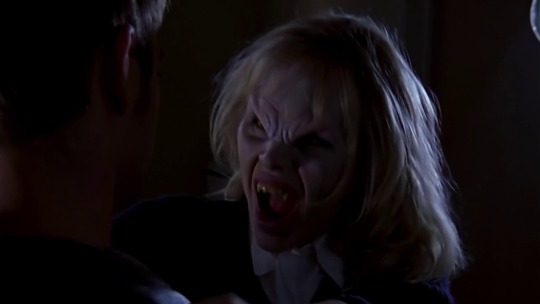
And of course, it all starts at good old Sunnydale High.
Our first glimpse of Buffy Summers begins with her in the middle of a nightmare, which... girl, get used to this plot device. This one is a bit more muddled than her later dreams, made up of a bunch of clips that’ll be used in later episodes that culminate in the Master, the season’s Big Bad.
I had to smile at the sight of those yellow school buses pulling up at the front of Sunnydale High. Buffy may not arrive at school in one of these things, but seven years later, she’s sure as hell going to leave in one.

Joyce – and later on, Angel – are both perfect examples of Characterization Marches On regarding the fact the writers’ room hasn’t quite settled on their personalities yet. In Joyce’s case, she comes across as a lot more flaky than in later appearances.
Oh, and here’s Xander, riding in on a skateboard that we’ll never see him use again across the entire run of the series. I get that he’s a very contentious character in the annals of the show, and though I’m certainly not going to let him off the hook for his occasional (frequent?) shitty behaviour, I also think I’m fonder of him than the average fan.
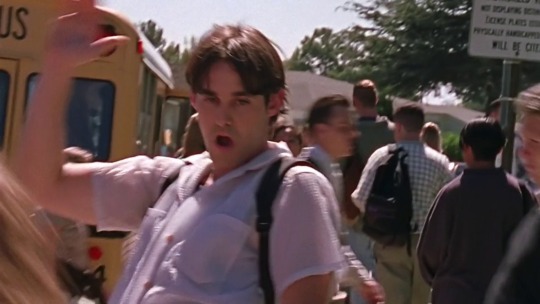
Honestly, I think Joss Whedon doomed him a little when he stated that Xander was the character most based on him in high school. Suddenly all his entitled, chauvinist behaviour was re-evaluated through the lens of knowing that Whedon was a pretty awful person – but I hope we can all agree that even at his worst, Xander is a MUCH better human being than Whedon.
We’ll see how we go.
Interesting that Willow’s history with Xander is established well before she meets Buffy. Not surprising, since they’ve known each other since early childhood, but interesting. Buffy is the protagonist, but Xander/Willow’s relationship with each other takes precedence when it comes to introducing the gang’s dynamics.
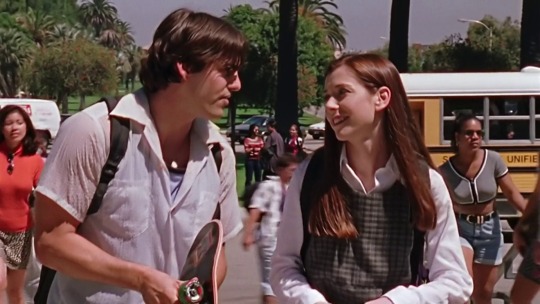
And hey, it’s Eric Balfour as Jesse! Oh man, they really dropped the ball on this character, didn’t they. It’s the one aspect of this two-part premiere that really doesn’t work... but I’ll get to that in good time.
Principle Flutie! Something else I’d totally forgotten; I honestly thought this show started with Snyder.
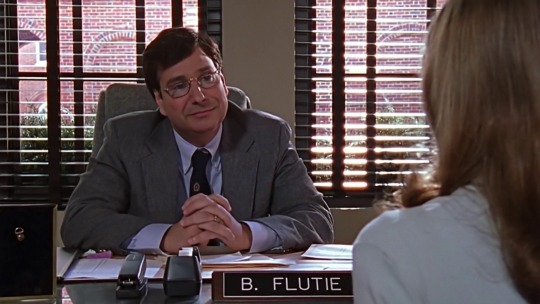
Also, that initial on his desk plaque is B. Does that mean his name is actually Bob (which is what he tells Buffy to call him)? Not Robert? Weird.
Buffy and Xander’s meetcute involves him helping her pick up some of the spilled contents of her bag, and accidentally saying: “can I have you?” instead of “can I help you?” Oof. Yeah, that’s not an auspicious start.
Buffy meets Cordelia before she meets Willow, and Cordelia comes across as surprisingly nice when she shares her textbook with Buffy and invites her into Sunnydale's popular clique. Then of course, the second relatively big twist of the episode occurs: Cordelia reverts into absolute bitchiness when they come across Willow at the drinking fountain.
Willow scarpers and Buffy looks deeply uncomfortable. There’s a nice subtext across this episode that suggests Buffy was once just like Cordelia, only for her calling to make her more sympathetic to social “losers” like Xander and Willow.


Cordelia also describes the Bronze as being in “the bad part of town”. Huh? I’m going to chalk that one down to more Early Instalment Weirdness, since I don’t think it ever comes up again. (Later Sunnydale is described as a “one Starbucks town”, which is also funny since it’s later revealed to contain a zoo, a shopping mall, several lakes and parks, a military base, and a university).
Buffy enters the library for the first time, and the first thing she sees is a newspaper with an article titled “local boys still missing” outlined in red. The plurality of “boys” means that this isn’t referring to Darla’s kill, which probably only happened the night before anyway. Instead, it’s an indication that there are ongoing problems of a supernatural nature in Sunnydale.
And here’s Giles! The most interesting thing about this interaction is that Giles has clearly been waiting for Buffy. As in, he knows that the Slayer is scheduled to appear in Sunnydale, and that she’s going to be enrolled in its local high school. As Willow says later on, he’s also a newcomer, having only recently taken the position of school librarian.

The show never goes into any more detail than this, but I have so many questions. Clearly Buffy was under surveillance from the Watchers Council, who knew she was coming and made sure Giles had a cover story and a position to fill at Sunnydale High so that he could more easily sidle himself into her life, but a part of me wonders they pulled similar strings for Joyce to get her that job at the art gallery in order to bring Buffy to Sunnydale in the first place.
Evidence for this is that Giles already knows it’s a hotbed for supernatural activity in his discussions with her, though I suppose his dialogue suggests it’s more fate (or the Powers That Be?) rather than the Watchers Council that had a hand in Buffy’s arrival at the Hellmouth (“there’s a reason you’re here and a reason why it’s now”). Still, it’s an interesting theory to ponder, and I always felt it was a shame that the show never delved too deeply into Buffy’s life after she became a Slayer but before she moved to Sunnydale.
(Though I suppose that had to do with the spectre of the 1992 Buffy movie, who’s relationship with this show is a bit tenuous. But now I’m getting off-track).
Buffy flees from Giles and strikes up a conversation with Willow instead. Willow’s eagerness and earnestness is very cute, and though she probably has the most profound development of any other character on this show, I’ll always miss this early dorky version of her.


In describing the library, Buffy says it gives her “the wiggins”. HAH! Remember that word? Remember how it didn’t exist anywhere except this show? Remember how it was essentially Whedon’s attempt to make fetch happen? Aw, man. What a delightful throwback.
On hearing that a body has been found stuffed in a locker, Buffy naturally cannot help but investigate – though I suppose we can chalk it down just as much to her wanting confirmation on whether or not vampires are in town than to any personal sense of responsibility.
Our first glimpse of her super strength comes when she busts through the locked door into the changing room, and she gives a weary “oh great” on seeing the bitemarks in the victim’s neck.
But then of course, she follows this up by sharing her discovery with Giles, who is quick to point out that she’s doing something about it. I have a soft spot for heroes who simply cannot walk away from danger and/or a situation that needs their intervention, regardless of how loudly they grumble about it.
Turns out Xander has heard their entire conversation about vampires and Watchers and Slayers from behind the stacks... which is an elegant not-coincidence since it was established earlier in the episode (in his conversation with Willow) that he was going to the library for a trigonometry book.

Giles is still jabbering about how Sunnydale is a centre of mystical energy that attracts all kinds of supernatural beings, and Buffy’s skepticism naturally gives way to a panning shot of an underground cave where a formidable-looking vampire is intoning “the Sleeper will wake” over a pool of blood.
As villains go, the Master is obviously not particularly inspired, especially since he spends most of this season as a quintessential Orcus on His Throne, but it was also way too early in the game to have a complex or personal Big Bad. You can’t come out the gate with a Glory or an Angelus, and I think he serves his purpose just fine as a Nosferatu-esque spectre that a sixteen-year-old girl would understandably be intimidated by.

Ditto Luke as the show’s Starter Villain: a physical threat to Buffy without being all that interesting.
On Buffy’s way to the Bronze we get our first Angel sighting, and much like Joyce, his characterization is a bit off. He’s way too smarmy and negging, but also... kind of upbeat? It’s amusing to reflect that the writers room knew very little about him at this point, including the fact that he was a vampire (making his “I don’t bite” comment deeply ironic) so it’s lucky that they never filmed any of his scenes in daylight before the truth comes out six episodes later.

In any case, his role in this episode is to namedrop things like “the Mouth of Hell” and “the Harvest” (which Giles will start researching as soon as Buffy passes them on to him) and give Buffy the silver crucifix which... becomes important at some stage? I remember the claddagh ring in season three, but have no recollection of this necklace.
Also intriguing is this dialogue between them: Angel – “I’m a friend.” Buffy – “Maybe I don’t want a friend.” Angel – “I didn’t say I was yours.”
I mean, I know it’s just meaningless banter, but Buffy assumes the “friend” he’s talking about is Giles, who soon confirms that he’s never met him before. So was Angel actually referring to The Powers That Be? Whistler, maybe? Again, I know that this was just filler dialogue with no established context, but I’d be interested to see if it fits in with season two’s flashbacks where he’s introduced to Buffy from a distance.
There’s a very sweet interaction between Buffy and Willow at the Bronze, in which the former gives the latter some advice (“seize the day, because tomorrow you might be dead”) and assures her she’s coming back – despite Willow’s expectation that she won’t – when she spots Giles on an overhead balcony.
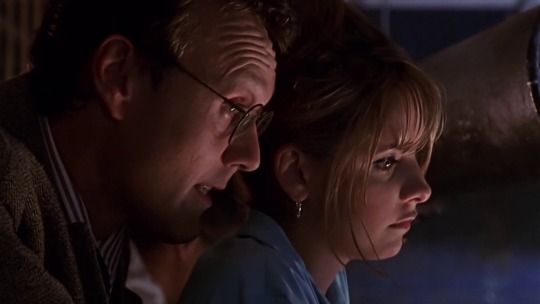
The staging of the scene between her and Giles is a bit sus – did he really have to stand behind her and lean over her like that? – but at his insistence she spots a vampire in the crowd, though not because of her preternatural senses, but because of his dated fashion sense. And uh-oh, he’s chatting up Willow, who is unfortunately taking Buffy’s “seize the day” advice.
A throwaway line from Cordelia down on the dance floor is telling: apparently her mother never gets out of bed. Our resident Alpha Bitch clearly doesn’t have a great home life.
Poor Jesse gets the brush-off from Cordelia and runs straight into Darla instead. The reveal is wonderfully corny, in which she swivels around in her hanging basket chair with a smile that wouldn’t melt butter.

We’re heading into the third act cliff-hanger now: Willow is being ushered through a graveyard by her vampiric date, Jesse is clearly also in danger, the Master has risen and sent out his minions to bring him fresh blood, and Xander’s skepticism over Buffy’s Slayer status quickly turns to concern when he learns that Willow is in trouble.
They all converge in a graveyard crypt, and – bless her – Buffy is bantering right off the bat. It’s actually a pretty good tactic, as the vampires are caught off-guard by her confidence. Though... shouldn’t Darla clock the fact that she’s a Slayer? We learn later that she’s familiar with the concept, though this is obviously another case of not having figured out the character’s background at this early stage.

A point in Xander’s favour: Buffy tells him to “go” and instead he enters the crypt to help Jesse and Willow. You have to admit, that’s classic Xander.
And we end with Xander/Willow/Jesse being threatened by more vampires outside, as Luke lowers himself onto Buffy after he’s thrown her into an open tomb. To be continued...
Miscellaneous Observations:
Do we ever get an explanation for the force field that’s keeping the Master trapped underground? It’s obviously magic, so who put it in place?

How did Angel know about the Harvest? Who sent him? I know the answers are still to come, but the question is deliberately left dangling in this episode.
Giles mentions incubus and succubus in his litany of monsters that are attracted to Sunnydale, but I think they’re the only two creatures that never actually appear in the show.
I love the little glimpses of non-main characters going about their business in Sunnydale, namely Aphrodesia and Aura gossiping about Buffy before the dead guy falls out of the latter’s locker. I wonder if those girls made it to Graduation Day...
Watching this episode, the most eye-opening character is Cordelia, who has quite the epic journey ahead of her. It’s almost funny to see her in a role that requires her to be little more than Buffy’s antagonist and foil – essentially what Buffy would have been without her calling. I’m taking a moment to think about where all these characters end up, and it’s pretty dizzying.
Giles gives the famous Slayer mantra: “Into every generation a Slayer is born: one girl in all the world, a Chosen One. She alone will wield the strength and skill to fight the vampires, demons, and forces of darkness; to stop the spread of their evil and the swell of their number. She is the Slayer.” This is repeated in the show’s very final episode, and not only forms the crux of Buffy’s entire identity crisis, but also serves as the inspiration for her solution to it. Damn, I love this show.
But who the heck is the guy who speaks these lines in the opening introduction?? It’s later taken over by Anthony Stewart Head, but in season one at least we get a completely unfamiliar narrator.
As excited as I am to embark on this rewatch, I know that after the third season the show loses its centre a bit as the main trio form relationships that are ostensibly more important than the one they have with each other. I love these early seasons because their friendship is clearly the focus of the show – the thing not only protecting them against the forces of evil, but getting them through the hell that is high school.
The show loses its lustre when it loses sight of their bond, but I have three whole seasons to enjoy before that happens. Let’s do this.
Best Line: Cordelia (after Buffy has accidentally slammed her against a wall, thinking she’s a vampire): “Excuse me, I have to call EVERYONE I have EVER met, RIGHT NOW.”
Best Scene: The climatic fight in the crypt, not for the fight itself, but for the shock on Xander and Willow’s faces as the world (and their lives) irrevocably change.
Best Subversion: Obviously when the vulnerable and demure little blonde in the Cold Open reveals herself to be the real danger in the room.
Death Toll: Darla's date in the cold open. Thomas, the vampire that Buffy dusts in the crypt. Also, the newspaper in the library mentioned "local boys still missing" but since we never see them on-screen, the toll stands at TWO.
Grand Total: One civilian, one villain.
#buffy the vampire slayer#rav's watching log#welcome to the hellmouth#rav's buffy rewatch#buffy season one
13 notes
·
View notes
Text
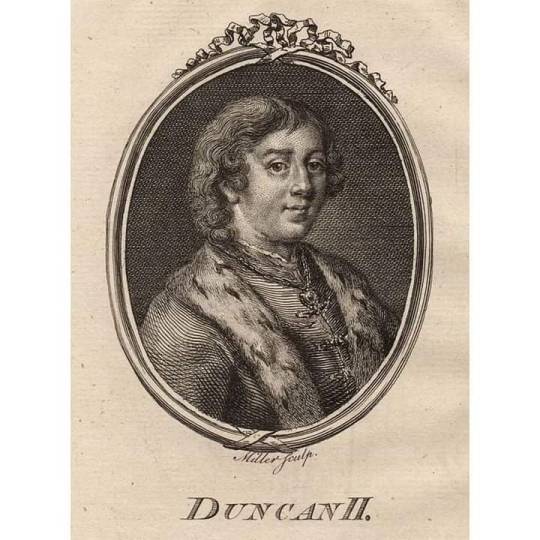
12th November 1094 saw King Duncan II killed at the Battle of Monthechin, near Kincardine.
We know very little about the battle, but a little background from the Annals of Ulster record that the "French went into Scotland and brought away the son of the king of Scotland as hostage" in 1072, which presumably refers to Duncan as any of his half-brothers (if then born) would have been infants at the time.
Duncan was kept in Normandy, Florence of Worcester in the Chronicon ex chronicis records that Robert III "Curthose" Duke of Normandy released "Ulfam Haroldi quondam regis Anglorum filium, Dunechaldumque regis Scottorum Malcolmi filium" from custody after his father's death in September 1087, knighted him and allowed them to leave Normandy.
He joined William II King of England and remained at his court in England. Florence of Worcester again records that Duncan served in the army of King William II, who supported his bid to depose his uncle, and to whom Duncan swore fealty before leaving for Scotland. He deposed his uncle in 1094 and proclaimed himself Duncan II King of Scotland after his brother's death but that "filius regis Malcolmi Dunechain" expelled "patruum suum Dufenaldum".
Another chronicle, The Annals of Inisfallen record that "Domnall son of Donnchadh" killed "Donnchadh son of Mael Coluim king of Alba" in 1094 and "took the kingship of Alba".
So to put it all together, Duncan was taken as a hostage to stop his faither, King Malcolm III, from attacking Northern England, he would not have been held as a prisoner, but brought up with the royal household of William I, eventually being knighted and taking a role in the English court. He would know his heritage though and must have had one eye on returning to Scotland and taking his place as King one day.
Malcolm meanwhile had given refuge to Edgar Ætheling, who seen himself as the rightful King of England, Edgar persuaded Malcolm to help him regain the English throne for The Wessex family......more on this tomorrow, but the upshot was Malcolm was slain and Duncan, with the Norman’s help took the Scottish throne in the Spring 1094. There was much opposition to this, especially from the Highland Scots who seen him as an outsider, and in November news reached the Highland army that Duncan was exposed, the army rode south to the Lowlands and confronted his nephew. On 12th November, Duncan was ambushed and killed in battle, having reigned for less than seven months.
As I said earlier not much is known about the battle and the Chronicles are a bit contradictory and really a bit confusing, but in the main they all point to Donald being behind the battle, one source says he was Duncan’s brother, but historians point out that he was more likely his uncle. Confused? Me too!
At the end of the day this was all down to the Gaels making a stand against the southerners taking control of the Scottish Crown, Donald III reigned for three years, being deposed by his half brother Edgar, another of Malcolm III’s sons, you could also say it was a family fight as two of Malcolm’s sons, Duncan, and Edgar and his brother Donald are all part of this story. Malcolm III influence did not only extend to those three relatives though, a further two sons, Alexander I and David I both went on to rule Scotland as Kings of the House of Dunkeld, a dynasty that only ended when Margaret of Norway perished in 1286.
The pic of Duncan, is one of the series of fictitious portraits of early Scottish kings by 17th century artist Jacob de Wet.
The sources from the chronicles come mainly from this source https://buist-keatch.org/buist/goring/3160.html
“Tune” in tomorrow for more background on Malcolm III and his demise.
13 notes
·
View notes
Text

ASOIAF FANCASTING --> EVERY NAMED FEMALE CHARACTER ABOVE THE AGE OF FIVE, PART VI
Goodwife Amabel (main series era): A servant from Lady Shella Whent's household in Harrenhal. She is friends with Goodwife Harra, and they oversee the prisoners brought to Harrenhal by Gregor Clegane's men. When Harra is executed by Lord Bolton after Arya sets the northmen free, Amabel is distraught. By the time Jaime arrives at Harrenhal on his way to lift the siege of Riverrun, Amabel is gone. Fancast: Glenis Levistam.
Amanda Arryn (b. approx. 74 AC): Daughter of Lord Rodrik Arryn of the Eyrie and his first wife. Princess Daella Targaryen became her stepmother. Amanda welcomed her and wrote letters on her behalf. Fancast: Alexandrea Owens-Sarno.
Amarei Crakehall (c. 230-264 AC): Third wife of Lord Walder Frey and mother to seven of his children. Fancast: Alexandra Tydings.
Septa Amarys (lived around 131 AC): She was tasked with the religious instruction of Baela Targaryen, daughter of Prince Daemon Targaryen, but did not succeed in taming her wild nature. Fancast: Julie Andrews.
Amerei Frey (b. 282 AC): Daughter of Merrett Frey, Lord Walder's ninth son, and his wife Mariya Darry. She is the granddaughter of Amarei Crakehall. After being caught with three grooms in the stables, Amerei is married off to a hedge knight, who is later slain by Gregor Clegane. She is then married to Lancel Lannister in order to strengthen his hold on Darry lands, but Lancel dissolves the marriage. Fancast: Hudson Leick.
The Amethyst Empress (Age of Heroes): Legendary eighth ruler of the Great Empire of the Dawn and descendant of the gods. She was usurped and slain by her brother, the treacherous Bloodstone Emperor. According to the annals of the Further East, this act ushered in the Long Night and ended the Empire of the Dawn. Fancast: Li Bingbing.
Annara Farring (c. 270-298 AC): Lord Walder Frey's seventh wife and mother to six of his children. Fancast: Erin Cummings.
Anya Waynwood (main series era): Lady of Ironoaks and Head of House Waynwood. She has three sons and many daughters and grandchildren. Harrold Hardyng, the heir to the Vale, is her cousin and ward. She is one of the Lords Declarant who swear to drive Petyr Baelish out of the Vale after Lysa Arryn's death. However, Petyr manages to manipulate the situation to his advantage and even persuades Anya to allow Harrold to marry his bastard daughter, Alayne Stone, who is really Sansa Stark in disguise. Fancast: Maggie Smith.
Anya Weatherwax (b. 126 AC): She was presented to King Aegon III Targaryen at the Maiden's Day Ball after the death of his first wife. She told the king of her horse Twinklehoof, whom she loved very much. Fancast: Aubrey Elise.
Aregelle Stark (b. approx. 180 AC): Second daughter of Serena Stark and her husband Edric Stark, who was also her uncle. Serena was the younger daughter of Rickon Stark, who was the heir to Winterfell before his death, but none of Rickon's descendants inherited Winterfell. Aregelle's older twin brothers, Cregard and Torrhen, probably died young. Aregelle was married to Lord Robard Cerwyn and bore him children. Fancast: Lily Sullivan.
Previous
#asoiaf fancast#valyrianscrolls#amerei frey#amarei crakehall#septa amarys#aregelle stark#anya weatherwax#anya waynwood#annara farring#the amethyst empress#amanda arryn#goodwife amabel#asoiaf fashion#allfancasts
16 notes
·
View notes
Text
Corsova is the name given to my invented world as a whole.
In-universe the name Corsova refers to the principle timeline in a vast multiverse called Pluralia.
Pluralia is largely unknown to the sentient beings alive in the Corsova dimension, because it is so far beyond comprehension. In order to understand Pluralia, one must join the Mindlink and achieve meta-consciousness, which is not possible until all sentient beings are Linked in a great network of minds.
The Corsova timeline spans the dawn to the end of the timeline (big bang to heat death), tracing the development of the various sentient groups as they struggle out of a mythic prehistory into achieving Mindlink and joining Pluralia.
The principle action takes place on the planet Corsova 3, and the principle actors are the human and the Fae. Originally evolved from a common ancestor and destined to become one species again called Corsovii, the history of the Corsovan timeline is the struggle to reconcile old hatreds and prejudices and band together for their common good and survival.
The history of Corsova 3 runs through seven Epochs, each one drawing from different mythic sources, cultural beliefs, and fictional genres. While the primary genre is epic fantasy, as the technological and magical knowledge develops, new genres are layered in. The 3rd Epoch is your expected high fantasy epic while the 5th Epoch has layered steampunk into the fantasy (the steam is distilled vapor from a species of magical tree) where magic and tech have merged into Majtech (Artificing, which is more advanced spell weaving, and Contraptioning, which is more clockwork and mechanical), and the 6th Epoch has a fantasy/cyberpunk/ecopunk mix).
There are five major series in Corsova:
2nd Epoch: Annals of the Witch-Lords (projected 3 volumes)
3rd Epoch: The Word and the Sword saga (12 volumes, completed)
4th Epoch: Wars of the Merchant Kings (projected 4 novels)
5th Epoch: Iron Skies cycle (WIP, 5 volumes)
6th Epoch: untitled fantasy/cyber-eco-punk series (projected 3 volumes)
1 note
·
View note
Text
Analyst Mat Piscatella Highlights GTA 6 as Game Industry's Watershed Moment
Mat Piscatella, an esteemed industry analyst, has sparked conversation by positing that the impending release of GTA 6 from Rockstar Games could signify a profound shift in the annals of video gaming.
For devoted fans eagerly awaiting the next installment in the Grand Theft Auto franchise, the anticipation has been palpable for the past decade. Finally, the veil of secrecy surrounding this highly anticipated addition to the beloved series is set to be lifted.
Assuming no unforeseen setbacks, 2025 is poised to be the year when players can finally immerse themselves in the world of GTA 6. While this milestone is undeniably monumental for fans, Piscatella suggests that its repercussions may reverberate far beyond the gaming community.
Is GTA 6 Destined to Make Gaming History?
At first glance, Piscatella's assertion may seem hyperbolic. However, upon deeper scrutiny, it becomes apparent that his claim carries substantial weight. In an interview with GamesIndustry.biz, he shed light on the challenges confronting the gaming industry in 2024. With fewer standout titles in the current year following a deluge of releases in the preceding year, unexpected phenomena like Palworld and Helldivers 2 have unexpectedly risen to prominence, eclipsing traditional AAA blockbusters.

As the industry looks toward the horizon, the success of games like GTA 6 assumes paramount importance in rejuvenating consumer interest and expenditure. Piscatella optimistically foresees, "While this year may present its challenges, the prospects for 2025 appear promising. If interest rates decline and funding becomes more accessible for developers and publishers, we can anticipate a resurgence in the development cycle."
Indications suggest a potential early 2025 release for GTA 6, hinted at by a newly created localization role at Rockstar. This revelation should come as a source of relief for fans who have long awaited the highly anticipated title.
"We anticipate an unprecedented level of anticipation surrounding the launch of GTA 6. Arguably, there has never been a release of such pivotal significance in the history of the industry. The stakes are remarkably high," asserts Piscatella.
The pressure on Rockstar Games is undoubtedly immense, likely contributing to the protracted development period of the forthcoming title. However, Take-Two Interactive's downward revision of profit estimates from eight to seven billion dollars for fiscal year 2025 suggests a potential internal delay for GTA 6.
When a game holds such unparalleled importance in the industry, ensuring its readiness for launch becomes paramount.
https://bfs.ucmerced.edu/sites/bfs.ucmerced.edu/files/webform/gta-5-modded-accounts.pdf
https://cris.unu.edu/sites/cris.unu.edu/files/webform/GTA-5-Modded-Accounts.pdf
youtube
1 note
·
View note
Text
Unraveling the Watergate Seven: A Deep Dive into Political Infamy
The Watergate scandal, a seismic event in the annals of American political history, not only precipitated the downfall of President Richard Nixon but also introduced the world to the "Watergate Seven." This moniker refers to seven of Nixon's advisors and associates embroiled in the scandal following the 1972 break-in at the Democratic National Committee headquarters at the Watergate office complex in Washington, D.C. Their actions, and the subsequent cover-up, would lead to a constitutional crisis, culminating in Nixon's resignation—the only time a U.S. president has resigned from office.
The Core Seven
The Watergate Seven comprised key figures within Nixon's administration and reelection campaign, each playing distinct roles in the scandal and its aftermath. Here's a closer look at these individuals:
- H.R. Haldeman: Nixon's Chief of Staff, Haldeman was deeply involved in the cover-up efforts. His unwavering loyalty to Nixon ultimately contributed to his downfall.
- John Ehrlichman: As Assistant to the President for Domestic Affairs, Ehrlichman oversaw the "plumbers," a covert unit established to stop leaks of classified information, among other duties.
- John N. Mitchell: The former Attorney General and later the head of Nixon's reelection campaign, Mitchell was implicated in both the planning and cover-up of the Watergate break-in.
- Charles Colson: Special Counsel to the President, Colson was known for his role in orchestrating the break-in and other "dirty tricks" against political opponents.
- Gordon C. Strachan: An aide to Haldeman, Strachan was involved in the transfer of information and funds to the Watergate burglars.
- Robert Mardian: Serving as a political aide, Mardian played a part in the early stages of the cover-up before his case was severed during the trial due to insufficient evidence.
- Kenneth Wells Parkinson: A lawyer for Nixon's reelection committee, Parkinson was involved in the legal aspects of the cover-up. He was ultimately acquitted, highlighting the complexities of proving guilt within the tangled web of the scandal.
These individuals faced charges including conspiracy, obstruction of justice, and perjury, reflecting the lengths to which Nixon's administration went to hide its activities. The trials and convictions (except for Parkinson) of these figures underscored the gravity of the administration's actions and led to significant political and legal reforms in the United States.
The Indictments and Aftermath
In March 1974, these seven individuals were indicted by a grand jury for their roles in the Watergate cover-up. The charges ranged from conspiracy, obstruction of justice, to perjury, laying bare the extent of the administration's illegal activities. The trials that followed would captivate the nation, revealing a sordid tale of political espionage, sabotage, and ethical compromise at the highest levels of government.
The convictions and subsequent incarcerations of several members of the Watergate Seven underscored the scandal's gravity. Moreover, their legal battles and Nixon's eventual pardon of some underscored the profound challenges to the legal and political systems of the United States.
Legacy and Reform
The Watergate scandal and the actions of the Watergate Seven (both groups) had profound and lasting effects on American politics and governance. It led to the resignation of President Nixon in August 1974, a moment unparalleled in U.S. history. In response to the scandal, Congress enacted a series of reforms aimed at improving transparency in government and reducing the influence of money in politics, including the Federal Election Campaign Act amendments and the creation of the Federal Election Commission.
Furthermore, Watergate left a lasting legacy on American political culture, introducing a level of skepticism toward political leaders and institutions. It also led to a significant shift in journalistic practices, with investigative journalism gaining prominence and credibility for its role in uncovering the truth behind the scandal.
The Watergate Seven, emblematic of a broader culture of secrecy and illegality within the Nixon administration, forever altered the American political landscape. The scandal led to sweeping reforms aimed at increasing transparency and accountability in government, including the passage of the Federal Election Campaign Act amendments and the creation of the Federal Election Commission.
Moreover, Watergate instilled in the American public a deep-seated skepticism towards political leaders, a legacy that persists. It served as a stark reminder of the fragility of democracy and the importance of vigilance and integrity in public office.
The Watergate Seven, symbolize a watershed moment in American political history. Their actions and the subsequent fallout highlighted the importance of accountability, transparency, and the rule of law in safeguarding democracy. The legacy of Watergate continues to influence political discourse, governance, and public trust in elected officials, serving as a powerful reminder of the consequences of political malfeasance.
Read the full article
1 note
·
View note
Text
Unveiling the Thrills and Triumphs of the Daytona 500: A Legendary Race
The Daytona 500 stands as a pinnacle of motorsport excellence, capturing the hearts of racing enthusiasts worldwide with its blend of speed, skill, and sheer adrenaline. Held annually at the Daytona International Speedway in Florida, this iconic event marks the commencement of the NASCAR Cup Series season, setting the stage for high-octane drama and unforgettable moments. In this article, we delve into the rich tapestry of the Daytona 500, exploring its history, significance, and the unparalleled excitement it brings to both drivers and fans alike.
A Brief History: Established in 1959, the Daytona 500 has evolved from humble beginnings into a cornerstone of American racing culture. Its inaugural race saw Lee Petty emerge victorious after a photo finish, cementing the event's reputation for nail-biting competition. Over the decades, the Daytona 500 has witnessed legendary rivalries, daring overtakes, and dramatic crashes, etching its name in the annals of motorsport history.
Significance: Beyond its status as a premier racing spectacle, the Daytona 500 holds profound significance within the NASCAR community. Winning the "Great American Race" is a career-defining achievement for drivers, propelling them into the spotlight and solidifying their legacy in the sport. The event also serves as a barometer for team performance, setting the tone for the grueling season ahead and showcasing the latest advancements in automotive engineering.
The Thrills of Race Day: Race day at Daytona is an electrifying experience, as fans flock to the Speedway to witness their favorite drivers battle for supremacy on the track. The roar of engines, the scent of burning rubber, and the palpable sense of anticipation create an atmosphere unlike any other in sports. From the pre-race festivities to the final lap showdown, every moment is infused with excitement and intensity, making the Daytona 500 a must-see event for motorsport enthusiasts of all ages.
Memorable Moments: The Daytona 500 has produced countless memorable moments that have transcended the confines of the racetrack. From Richard Petty's record-setting seven victories to Dale Earnhardt's long-awaited triumph in 1998, each edition of the race has added another chapter to its storied history. Iconic finishes, such as the infamous last-lap crash in 1976 immortalized in the film "Days of Thunder," have only served to enhance the event's legendary status.
The Future of the Daytona 500: As the Daytona 500 continues to captivate audiences around the globe, its legacy remains as vibrant as ever. With advancements in technology shaping the future of motorsport, the event is poised to enter a new era of innovation and excitement. From hybrid engines to autonomous vehicles, the possibilities for the Daytona 500 are endless, ensuring that its legacy will endure for generations to come.
0 notes
Text
Unveiling the Secrets of Delhi's Siri Fort: A Historical Marvel
Delhi, the capital city of India, is a treasure trove of historical and architectural marvels. Among these, Siri Fort stands as a testament to the city's rich heritage and historical significance. In this article, we will delve into the intriguing history, architectural brilliance, and cultural relevance of Siri Fort, ensuring you are well-informed and captivated by this fascinating destination.
Historical Legacy of Siri Fort
Siri Fort, located in South Delhi, holds a prominent position in the annals of Delhi's history. Constructed during the reign of Alauddin Khalji in the early 14th century, Siri Fort was part of a series of seven cities built to fortify the capital. It played a crucial role in guarding the city from invasions and was witness to significant historical events, including battles and power struggles.
Architectural Marvels of Siri Fort
The architecture of Siri Fort reflects the military ingenuity of the medieval era. Built using rubble masonry, the fort exhibits a blend of Indo-Islamic architectural styles, incorporating elements from both Islamic and Hindu architectural traditions. The layout of Siri Fort is strategic, with walls and bastions designed for defense and protection.
One of the striking features of the fort is the unique combination of the traditional 'L' shape and irregular contours, setting it apart from typical fortifications of that period. The fort complex comprises a mosque, residential areas, a water tank, and other structures that provide insights into the architectural grandeur of its time.
Cultural and Recreational Significance
Siri Fort has not only historical but also cultural and recreational significance. Today, it hosts cultural events, exhibitions, and performances that attract artists, art enthusiasts, and the local community. The Siri Fort Auditorium, within the fort complex, is a hub for cultural events, providing a platform for various artistic endeavors, from theater to music and dance.
Present-Day Status and Preservation Efforts
Preservation of historical sites like Siri Fort is of paramount importance. Efforts by the Archaeological Survey of India (ASI) and other heritage organizations ensure that this significant monument is maintained and conserved for future generations. Restoration work, guided tours, and educational programs contribute to the preservation of Siri Fort’s historical and cultural legacy.
Visiting Siri Fort: A Journey through Time
Visiting Siri Fort allows you to step back in time and experience the grandeur and historical richness of medieval Delhi. The fort, with its remnants and structural layout, offers a fascinating glimpse into the military strategies and architectural brilliance of that era.
In conclusion, Siri Fort stands as a testament to Delhi's dynamic past, showcasing the city's resilience and fortitude throughout centuries. Exploring this historical marvel is a journey through time, enabling us to connect with Delhi's heritage and immerse ourselves in its intriguing history. Plan your visit to Siri Fort and embark on an enriching adventure through Delhi's vibrant past.
0 notes
Text
The NCAA Softball Championships are the pinnacle of collegiate softball, an annual showcase of the sport's brightest talent and the culmination of a season's worth of thrilling competition. The road to the championship is a demanding one, filled with high-stakes games, dramatic upsets, and remarkable feats of athleticism. This article will take you on a journey through the history of the NCAA Softball Championships, highlighting the memorable moments, legendary teams, and standout players that have shaped the tournament's rich legacy.
A Journey Through the NCAA Softball Championships
The first NCAA Women's College World Series was held in 1982, marking the beginning of the NCAA Softball Championships. Since then, the tournament has grown in size and popularity, capturing the hearts of sports fans around the world.
The NCAA Softball Championship is more than just a tournament. It's a journey, a grueling test of resilience and skill that starts with hundreds of Division I softball teams from across the nation vying for the coveted title. As the season unfolds, teams face off in conference play, with the best advancing to the NCAA Softball Tournament, including the Super Regionals and eventually the prestigious Women's College World Series.
The Women's College World Series, the final stage of the NCAA Softball Championships, is held annually in Oklahoma City. It's a double elimination tournament that features the top eight teams from the Super Regionals, creating a thrilling finale to the softball season.
"In NCAA Softball, every game counts, every pitch matters, every play could be the difference between victory and defeat."
In the pursuit of the championship, teams are not just playing for a trophy. They are playing for school pride, for their teammates, and for a place in NCAA Softball history.
Memorable Moments and Remarkable Players
The NCAA Softball Championships have produced countless memorable moments and have served as the launching pad for many of softball's greatest players. It's a crucible where legends are made and heroes are born. One standout player who etched her name into the annals of the Championships is Montana Fouts of Alabama. Fouts threw a perfect game in the 2021 Women's College World Series, becoming only the fifth pitcher in WCWS history to accomplish such a feat.
Another compelling moment occurred during the 2005 Women's College World Series when Cat Osterman, pitching for Texas, racked up an incredible 17 strikeouts in a seven-inning game. This remarkable achievement has cemented Osterman's place in softball history.
For a complete record of these historical moments and a look at the standout players over the years, our dedicated section on NCAA Women's Softball offers a comprehensive guide.
Understanding the Bracket System
Understanding the NCAA Softball Championships means not only appreciating the games themselves but also navigating the complex bracket system that decides which teams get to play. Every year, the selection committee places 64 teams into the NCAA Softball Brackets, with each team earning their spot through a mix of automatic qualifications and at-large bids.
This bracket system fuels much of the anticipation leading up to the tournament, as fans eagerly await to see which teams will be selected, and how the paths to the championship might unfold. Every twist and turn in the NCAA Softball Schedule adds to the thrill and suspense of the championships.
"The NCAA Softball Championships is not just a showcase of skill and athleticism, but also a testament to the power of teamwork, perseverance, and spirit."
The Journey to the Championship
Once the brackets are set, the tournament begins with regionals and super regionals. Here, teams battle it out to secure their place in the coveted Women's College World Series. It's in these critical games that the mettle of the teams is truly tested.
The double-elimination format means that even
after a loss, teams have a chance to bounce back and continue their journey towards the championship. These heart-stopping moments of triumph and defeat add to the narrative of the NCAA Softball Championships, producing legendary tales of comeback victories and hard-fought battles.
The Pinnacle of NCAA Softball
As the final stage of the NCAA Softball tournament, the Women's College World Series is the pinnacle of NCAA Softball. Here, the final eight teams duke it out for the ultimate honor – the NCAA Softball Championship. These games draw thousands of fans and are watched by millions more on television and online. The energy, passion, and high-stakes competition make this event one of the highlights of the sporting calendar.
Champions of the Past and the Future
The road to becoming NCAA Softball Champions is arduous and challenging, but those who emerge victorious earn their place in softball history. Over the years, we have seen powerhouse programs like UCLA and Arizona secure multiple titles, while other teams have tasted victory for the first time.
Looking towards the future, it's clear that the NCAA Softball Championships will continue to be a thrilling showcase of the very best in women's collegiate softball. As the sport grows and evolves, we can look forward to many more moments of victory, defeat, and sheer sportsmanship that make this tournament so special.
"Every year, the NCAA Softball Championships reaffirm why we love sports – the thrill of competition, the joy of victory, and the lessons learned in defeat. They remind us that at the end of the day, it's not just about winning, but also about how the game is played."
Remember to stay tuned to SportyConnect for the most accurate and up-to-date news on NCAA Softball and more.
0 notes
Photo
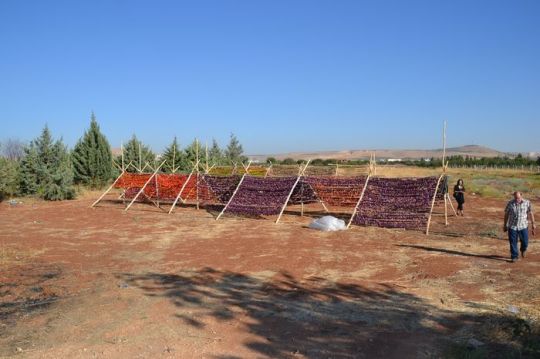
Justinian and his successors
For Justinian and his successors ransacked the empire to find the most precious materials for the ‘Great Church.’ The interior is still one vast pile of marble, porphyry, and polished granite, white marbles with rosy streaks, green marbles, blue and black, starred or veined with white. The pagan temples were stripped of their columns and capitals; monoliths and colossal slabs were transported from Rome, and from the Nile, from Syria, Asia Minor, and Greece, so that, with the Pantheon at Rome, this is the one example of a grand structure of ancient art which still remains unruined. The gilded portals, the jewels, pearls, and gold of the altar, the choir adornment of cedar, amber, ivory, and silver, have been long destroyed by the greedy soldiers of the Cross; and the mosaics above with seraphim, apostles, prophets, and Christ in glory have been covered up, but not destroyed, by the fierce soldiers of Mahomet.
It is a fact, almost without parallel in the history of religion, that the Musulman conquerors adopted the Chris-tian cathedral as their own fane, without injuring it, with very little alteration within, and even without changing its name. The Greeks did not adopt the form of Egyptian or Syrian temples; Christians took for the model of their churches the law-courts, but not the temples of Polytheism; Protestants have never found a practical use for the cruciform churches of Catholicism. But Islam accepted the Holy Wisdom as the type of its mosque ephesus sightseeing; partially concealed the Christian emblems and sacred mosaics, added without some courts and the four beautiful minarets, but made no structural change within. And thus the oldest cathedral in Christendom is the type of a thousand mosques; and the figures of Christ and his saints, that a Roman emperor set up in his imperial dome, look down to-day after fifteen centuries on the Westminster Abbey of the Ottoman Caliphs.
Byzantine history
What a dazzling panorama of stirring, pathetic, and terrific scenes press on the mind of the student of Byzantine history as he recalls all which that vast fane has witnessed in the thousand years that separate the age of Justinian from that of Suleiman the Magnificent: from the day when the great emperor cried out, ‘ I have surpassed thee, O Solomon ! ’ to the days when Ottoman conquerors gave thanks for a hundred victories over the Cross. Has any building in the world been witness to so vast a series of memorable events?
In historic memories, the walls of Constantinople can compare with her great Church; for the ruined walls are still the most colossal and pathetic relics of the ancient world that remain in Europe. Except the walls round Rome, there is no scene in Europe so strange,, so desolate, and mantled with such annals of battle, crime, despair, and heroism. Though the sea walls have been partly removed and much injured by man, the vast rampart on the west which stretches from Blachernae on the Golden Horn to the Seven Towers on the Marmora, a distance of nearly four miles, is still, but for natural decay and disturbance, in the state in which it was left by Sultan Mohammed the Conqueror in the fifteenth century. It was then more than a thousand years old; and during the whole of that period it had been increased, repaired, strengthened, doubled, and tripled.
It is still a museum or vast catacomb of Byzantine history. More fortunate than the walls of Rome and other ancient cities, the western walls of Constantinople have hardly been touched by the hand of man’since the Turks entered. This complicated scheme of circumvallation, far stronger than the walls of Rome or of any other ancient or mediaeval city, made an impenetrable barrier, whilst adequately manned and defended, down to the invention of the heavy cannon. We can still trace the plan and form of the triple line of wall, of the moat, of the two causeways, of the fourteen gates, and the one hundred and ninety-four towers, and the ruined ‘ palace of the later emperors.
Here and there the massive towers are riven and tottering, torn by cannon, earthquake, and centuries of neglect and decay. The shrunken city of Stamboul does not now touch them, and no populous suburbs have grown round them. Cemeteries with cypress and tombstones, the cupola of a small oratory, or the roof of a hospital, alone break the view. But the crumbling walls and towers stand in solitude amidst orchards and gardens, and nothing disturbs the student who deciphers inscriptions set up by Constantines, Leos, Basils, Comneni, and Palaeologi, and here and there a Roman eagle and a Greek cross.
0 notes
Photo

November 12th 1094 saw The Battle of Monthechin.
Also called The Battle of Mondynes after the area near in what is now Aberdeenshire, this was a bloody fight between the armies of Donald III Bane King Duncan the Second and his half brothers - Etmond mac Máel Coluim Edmund and Domnall mac Máel Coluim Donald
The background is Duncan, the son of King Malcolm lll by his first wife Ingibiorg, was sent to the English Court of William the Conqueror as a guarantee that Malcolm would not attack England. When Malcolm died his brother Donald Bain seized the throne, but with English support Duncan deposed his uncle to become Duncan II of Scotland or Donnchad mac Máel Coluim in ancient Gaelic.
It all came down to the succession to the throne, the old system of Tanistry had been replaced, Tanstry was a custom among various Celtic tribes, most notably in Scotland, where the king or chief of the clan was elected by family heads in full assembly, this system of succession left the headship open to the ambitious and was a frequent source of strife both in families and between the clans. Tanistry in Scotland wasn’t officially abolished until the reign of James I over 300 years later and replaced with Primogeniture, which is still used today, more or less, this system is where the paternally acknowledged, firstborn son to inherit his parent’s entire or main estate, this was in preference to illegitimate births, this is why Mary Queen of Scots had a right to the English throne, as Elizabeth was, in the eyes of the catholic church, illegitimate, but that’s a different story.
In Spring 1094, Duncan, Malcolm’s first born came north into Scotland with the support of an English and Norman army and deposed his uncle and his step-brother, placing himself on the throne as Duncan II. But Duncan was seen as acting on behalf of William II and he received very little support within Scotland. The withdrawal of William’s troops later in the year left Duncan very exposed.
Duncan was ambushed and killed in battle, having reigned for less than seven months. Primary sources are unclear about the exact manner of his death. The Annals of Inisfallen report that “Donnchadh [Duncan] son of Mael Coluim [Malcolm], king of Alba, was slain by Domnall [Donald], son of Donnchadh [Duncan]. That same Domnall, moreover, afterwards took the kingship of Alba.” The Annals of Ulster report that “Donnchad son of Mael Coluim, king of Scotland, was treacherously killed by his own brothers Domnall and Edmond”. As Duncan had no brothers by those names, the text probably points to his uncle Donald and half-brother Edmund, though later texts identify a noble by the name of Máel Petair of Mearns (Malpeder) as the actual murderer. The picture is a 167th century depiction of our short lived King of Alba one of a series painted by Jacob de Wet II, a Dutch artist working in Scotland from 1673 the series has eighteen full-lengths portraits which illustrate the genealogy of the royal house of Scotland from Fergus I (who ascended the throne in 330 BC) to James VII.
Confused, well the much more able Ian Colville explains it much better than an amateur like me on his blog here http://iainthepict.blogspot.com/…/11/death-of-duncan-ii.html
8 notes
·
View notes
Photo

Justinian and his successors
For Justinian and his successors ransacked the empire to find the most precious materials for the ‘Great Church.’ The interior is still one vast pile of marble, porphyry, and polished granite, white marbles with rosy streaks, green marbles, blue and black, starred or veined with white. The pagan temples were stripped of their columns and capitals; monoliths and colossal slabs were transported from Rome, and from the Nile, from Syria, Asia Minor, and Greece, so that, with the Pantheon at Rome, this is the one example of a grand structure of ancient art which still remains unruined. The gilded portals, the jewels, pearls, and gold of the altar, the choir adornment of cedar, amber, ivory, and silver, have been long destroyed by the greedy soldiers of the Cross; and the mosaics above with seraphim, apostles, prophets, and Christ in glory have been covered up, but not destroyed, by the fierce soldiers of Mahomet.
It is a fact, almost without parallel in the history of religion, that the Musulman conquerors adopted the Chris-tian cathedral as their own fane, without injuring it, with very little alteration within, and even without changing its name. The Greeks did not adopt the form of Egyptian or Syrian temples; Christians took for the model of their churches the law-courts, but not the temples of Polytheism; Protestants have never found a practical use for the cruciform churches of Catholicism. But Islam accepted the Holy Wisdom as the type of its mosque ephesus sightseeing; partially concealed the Christian emblems and sacred mosaics, added without some courts and the four beautiful minarets, but made no structural change within. And thus the oldest cathedral in Christendom is the type of a thousand mosques; and the figures of Christ and his saints, that a Roman emperor set up in his imperial dome, look down to-day after fifteen centuries on the Westminster Abbey of the Ottoman Caliphs.
Byzantine history
What a dazzling panorama of stirring, pathetic, and terrific scenes press on the mind of the student of Byzantine history as he recalls all which that vast fane has witnessed in the thousand years that separate the age of Justinian from that of Suleiman the Magnificent: from the day when the great emperor cried out, ‘ I have surpassed thee, O Solomon ! ’ to the days when Ottoman conquerors gave thanks for a hundred victories over the Cross. Has any building in the world been witness to so vast a series of memorable events?
In historic memories, the walls of Constantinople can compare with her great Church; for the ruined walls are still the most colossal and pathetic relics of the ancient world that remain in Europe. Except the walls round Rome, there is no scene in Europe so strange,, so desolate, and mantled with such annals of battle, crime, despair, and heroism. Though the sea walls have been partly removed and much injured by man, the vast rampart on the west which stretches from Blachernae on the Golden Horn to the Seven Towers on the Marmora, a distance of nearly four miles, is still, but for natural decay and disturbance, in the state in which it was left by Sultan Mohammed the Conqueror in the fifteenth century. It was then more than a thousand years old; and during the whole of that period it had been increased, repaired, strengthened, doubled, and tripled.
It is still a museum or vast catacomb of Byzantine history. More fortunate than the walls of Rome and other ancient cities, the western walls of Constantinople have hardly been touched by the hand of man’since the Turks entered. This complicated scheme of circumvallation, far stronger than the walls of Rome or of any other ancient or mediaeval city, made an impenetrable barrier, whilst adequately manned and defended, down to the invention of the heavy cannon. We can still trace the plan and form of the triple line of wall, of the moat, of the two causeways, of the fourteen gates, and the one hundred and ninety-four towers, and the ruined ‘ palace of the later emperors.
Here and there the massive towers are riven and tottering, torn by cannon, earthquake, and centuries of neglect and decay. The shrunken city of Stamboul does not now touch them, and no populous suburbs have grown round them. Cemeteries with cypress and tombstones, the cupola of a small oratory, or the roof of a hospital, alone break the view. But the crumbling walls and towers stand in solitude amidst orchards and gardens, and nothing disturbs the student who deciphers inscriptions set up by Constantines, Leos, Basils, Comneni, and Palaeologi, and here and there a Roman eagle and a Greek cross.
0 notes
Photo
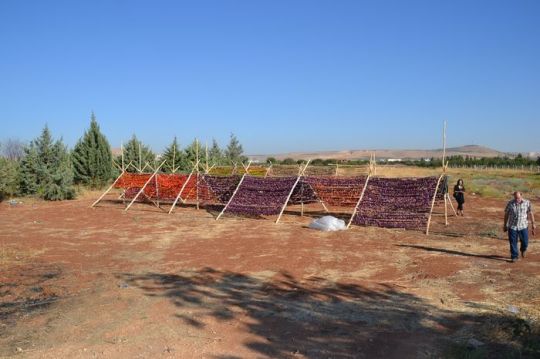
Justinian and his successors
For Justinian and his successors ransacked the empire to find the most precious materials for the ‘Great Church.’ The interior is still one vast pile of marble, porphyry, and polished granite, white marbles with rosy streaks, green marbles, blue and black, starred or veined with white. The pagan temples were stripped of their columns and capitals; monoliths and colossal slabs were transported from Rome, and from the Nile, from Syria, Asia Minor, and Greece, so that, with the Pantheon at Rome, this is the one example of a grand structure of ancient art which still remains unruined. The gilded portals, the jewels, pearls, and gold of the altar, the choir adornment of cedar, amber, ivory, and silver, have been long destroyed by the greedy soldiers of the Cross; and the mosaics above with seraphim, apostles, prophets, and Christ in glory have been covered up, but not destroyed, by the fierce soldiers of Mahomet.
It is a fact, almost without parallel in the history of religion, that the Musulman conquerors adopted the Chris-tian cathedral as their own fane, without injuring it, with very little alteration within, and even without changing its name. The Greeks did not adopt the form of Egyptian or Syrian temples; Christians took for the model of their churches the law-courts, but not the temples of Polytheism; Protestants have never found a practical use for the cruciform churches of Catholicism. But Islam accepted the Holy Wisdom as the type of its mosque ephesus sightseeing; partially concealed the Christian emblems and sacred mosaics, added without some courts and the four beautiful minarets, but made no structural change within. And thus the oldest cathedral in Christendom is the type of a thousand mosques; and the figures of Christ and his saints, that a Roman emperor set up in his imperial dome, look down to-day after fifteen centuries on the Westminster Abbey of the Ottoman Caliphs.
Byzantine history
What a dazzling panorama of stirring, pathetic, and terrific scenes press on the mind of the student of Byzantine history as he recalls all which that vast fane has witnessed in the thousand years that separate the age of Justinian from that of Suleiman the Magnificent: from the day when the great emperor cried out, ‘ I have surpassed thee, O Solomon ! ’ to the days when Ottoman conquerors gave thanks for a hundred victories over the Cross. Has any building in the world been witness to so vast a series of memorable events?
In historic memories, the walls of Constantinople can compare with her great Church; for the ruined walls are still the most colossal and pathetic relics of the ancient world that remain in Europe. Except the walls round Rome, there is no scene in Europe so strange,, so desolate, and mantled with such annals of battle, crime, despair, and heroism. Though the sea walls have been partly removed and much injured by man, the vast rampart on the west which stretches from Blachernae on the Golden Horn to the Seven Towers on the Marmora, a distance of nearly four miles, is still, but for natural decay and disturbance, in the state in which it was left by Sultan Mohammed the Conqueror in the fifteenth century. It was then more than a thousand years old; and during the whole of that period it had been increased, repaired, strengthened, doubled, and tripled.
It is still a museum or vast catacomb of Byzantine history. More fortunate than the walls of Rome and other ancient cities, the western walls of Constantinople have hardly been touched by the hand of man’since the Turks entered. This complicated scheme of circumvallation, far stronger than the walls of Rome or of any other ancient or mediaeval city, made an impenetrable barrier, whilst adequately manned and defended, down to the invention of the heavy cannon. We can still trace the plan and form of the triple line of wall, of the moat, of the two causeways, of the fourteen gates, and the one hundred and ninety-four towers, and the ruined ‘ palace of the later emperors.
Here and there the massive towers are riven and tottering, torn by cannon, earthquake, and centuries of neglect and decay. The shrunken city of Stamboul does not now touch them, and no populous suburbs have grown round them. Cemeteries with cypress and tombstones, the cupola of a small oratory, or the roof of a hospital, alone break the view. But the crumbling walls and towers stand in solitude amidst orchards and gardens, and nothing disturbs the student who deciphers inscriptions set up by Constantines, Leos, Basils, Comneni, and Palaeologi, and here and there a Roman eagle and a Greek cross.
0 notes
Photo

Justinian and his successors
For Justinian and his successors ransacked the empire to find the most precious materials for the ‘Great Church.’ The interior is still one vast pile of marble, porphyry, and polished granite, white marbles with rosy streaks, green marbles, blue and black, starred or veined with white. The pagan temples were stripped of their columns and capitals; monoliths and colossal slabs were transported from Rome, and from the Nile, from Syria, Asia Minor, and Greece, so that, with the Pantheon at Rome, this is the one example of a grand structure of ancient art which still remains unruined. The gilded portals, the jewels, pearls, and gold of the altar, the choir adornment of cedar, amber, ivory, and silver, have been long destroyed by the greedy soldiers of the Cross; and the mosaics above with seraphim, apostles, prophets, and Christ in glory have been covered up, but not destroyed, by the fierce soldiers of Mahomet.
It is a fact, almost without parallel in the history of religion, that the Musulman conquerors adopted the Chris-tian cathedral as their own fane, without injuring it, with very little alteration within, and even without changing its name. The Greeks did not adopt the form of Egyptian or Syrian temples; Christians took for the model of their churches the law-courts, but not the temples of Polytheism; Protestants have never found a practical use for the cruciform churches of Catholicism. But Islam accepted the Holy Wisdom as the type of its mosque ephesus sightseeing; partially concealed the Christian emblems and sacred mosaics, added without some courts and the four beautiful minarets, but made no structural change within. And thus the oldest cathedral in Christendom is the type of a thousand mosques; and the figures of Christ and his saints, that a Roman emperor set up in his imperial dome, look down to-day after fifteen centuries on the Westminster Abbey of the Ottoman Caliphs.
Byzantine history
What a dazzling panorama of stirring, pathetic, and terrific scenes press on the mind of the student of Byzantine history as he recalls all which that vast fane has witnessed in the thousand years that separate the age of Justinian from that of Suleiman the Magnificent: from the day when the great emperor cried out, ‘ I have surpassed thee, O Solomon ! ’ to the days when Ottoman conquerors gave thanks for a hundred victories over the Cross. Has any building in the world been witness to so vast a series of memorable events?
In historic memories, the walls of Constantinople can compare with her great Church; for the ruined walls are still the most colossal and pathetic relics of the ancient world that remain in Europe. Except the walls round Rome, there is no scene in Europe so strange,, so desolate, and mantled with such annals of battle, crime, despair, and heroism. Though the sea walls have been partly removed and much injured by man, the vast rampart on the west which stretches from Blachernae on the Golden Horn to the Seven Towers on the Marmora, a distance of nearly four miles, is still, but for natural decay and disturbance, in the state in which it was left by Sultan Mohammed the Conqueror in the fifteenth century. It was then more than a thousand years old; and during the whole of that period it had been increased, repaired, strengthened, doubled, and tripled.
It is still a museum or vast catacomb of Byzantine history. More fortunate than the walls of Rome and other ancient cities, the western walls of Constantinople have hardly been touched by the hand of man’since the Turks entered. This complicated scheme of circumvallation, far stronger than the walls of Rome or of any other ancient or mediaeval city, made an impenetrable barrier, whilst adequately manned and defended, down to the invention of the heavy cannon. We can still trace the plan and form of the triple line of wall, of the moat, of the two causeways, of the fourteen gates, and the one hundred and ninety-four towers, and the ruined ‘ palace of the later emperors.
Here and there the massive towers are riven and tottering, torn by cannon, earthquake, and centuries of neglect and decay. The shrunken city of Stamboul does not now touch them, and no populous suburbs have grown round them. Cemeteries with cypress and tombstones, the cupola of a small oratory, or the roof of a hospital, alone break the view. But the crumbling walls and towers stand in solitude amidst orchards and gardens, and nothing disturbs the student who deciphers inscriptions set up by Constantines, Leos, Basils, Comneni, and Palaeologi, and here and there a Roman eagle and a Greek cross.
0 notes
Photo

Justinian and his successors
For Justinian and his successors ransacked the empire to find the most precious materials for the ‘Great Church.’ The interior is still one vast pile of marble, porphyry, and polished granite, white marbles with rosy streaks, green marbles, blue and black, starred or veined with white. The pagan temples were stripped of their columns and capitals; monoliths and colossal slabs were transported from Rome, and from the Nile, from Syria, Asia Minor, and Greece, so that, with the Pantheon at Rome, this is the one example of a grand structure of ancient art which still remains unruined. The gilded portals, the jewels, pearls, and gold of the altar, the choir adornment of cedar, amber, ivory, and silver, have been long destroyed by the greedy soldiers of the Cross; and the mosaics above with seraphim, apostles, prophets, and Christ in glory have been covered up, but not destroyed, by the fierce soldiers of Mahomet.
It is a fact, almost without parallel in the history of religion, that the Musulman conquerors adopted the Chris-tian cathedral as their own fane, without injuring it, with very little alteration within, and even without changing its name. The Greeks did not adopt the form of Egyptian or Syrian temples; Christians took for the model of their churches the law-courts, but not the temples of Polytheism; Protestants have never found a practical use for the cruciform churches of Catholicism. But Islam accepted the Holy Wisdom as the type of its mosque ephesus sightseeing; partially concealed the Christian emblems and sacred mosaics, added without some courts and the four beautiful minarets, but made no structural change within. And thus the oldest cathedral in Christendom is the type of a thousand mosques; and the figures of Christ and his saints, that a Roman emperor set up in his imperial dome, look down to-day after fifteen centuries on the Westminster Abbey of the Ottoman Caliphs.
Byzantine history
What a dazzling panorama of stirring, pathetic, and terrific scenes press on the mind of the student of Byzantine history as he recalls all which that vast fane has witnessed in the thousand years that separate the age of Justinian from that of Suleiman the Magnificent: from the day when the great emperor cried out, ‘ I have surpassed thee, O Solomon ! ’ to the days when Ottoman conquerors gave thanks for a hundred victories over the Cross. Has any building in the world been witness to so vast a series of memorable events?
In historic memories, the walls of Constantinople can compare with her great Church; for the ruined walls are still the most colossal and pathetic relics of the ancient world that remain in Europe. Except the walls round Rome, there is no scene in Europe so strange,, so desolate, and mantled with such annals of battle, crime, despair, and heroism. Though the sea walls have been partly removed and much injured by man, the vast rampart on the west which stretches from Blachernae on the Golden Horn to the Seven Towers on the Marmora, a distance of nearly four miles, is still, but for natural decay and disturbance, in the state in which it was left by Sultan Mohammed the Conqueror in the fifteenth century. It was then more than a thousand years old; and during the whole of that period it had been increased, repaired, strengthened, doubled, and tripled.
It is still a museum or vast catacomb of Byzantine history. More fortunate than the walls of Rome and other ancient cities, the western walls of Constantinople have hardly been touched by the hand of man’since the Turks entered. This complicated scheme of circumvallation, far stronger than the walls of Rome or of any other ancient or mediaeval city, made an impenetrable barrier, whilst adequately manned and defended, down to the invention of the heavy cannon. We can still trace the plan and form of the triple line of wall, of the moat, of the two causeways, of the fourteen gates, and the one hundred and ninety-four towers, and the ruined ‘ palace of the later emperors.
Here and there the massive towers are riven and tottering, torn by cannon, earthquake, and centuries of neglect and decay. The shrunken city of Stamboul does not now touch them, and no populous suburbs have grown round them. Cemeteries with cypress and tombstones, the cupola of a small oratory, or the roof of a hospital, alone break the view. But the crumbling walls and towers stand in solitude amidst orchards and gardens, and nothing disturbs the student who deciphers inscriptions set up by Constantines, Leos, Basils, Comneni, and Palaeologi, and here and there a Roman eagle and a Greek cross.
0 notes